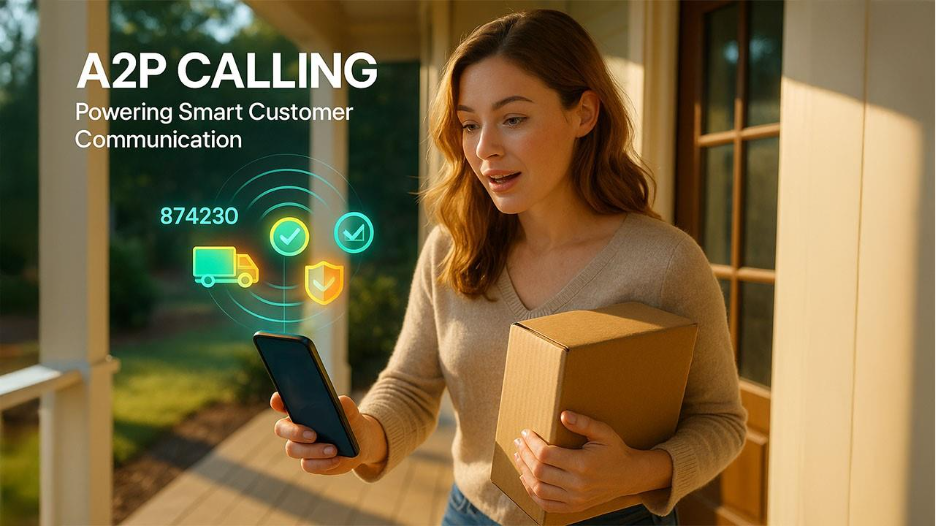Customer communication has changed rapidly over the last few years. People expect updates instantly, whether it is about a delivery arriving today or a login attempt on their account. This
Customer communication has changed rapidly over the last few years. People expect updates instantly, whether it is about a delivery arriving today or a login attempt on their account. This expectation has pushed businesses to look for smarter ways to reach customers without adding extra workload to their teams. That is where A2P calling steps in. It gives companies a simple and reliable way to send automated voice calls at scale while keeping communication personal and timely.
What A2P Calling Really Means
A2P calling, otherwise known as application to person calling, is the process by which software makes automated voice calls to customers. These are not the unsolicited spam calls you might imagine. These are structured, purposeful calls to share important information like OTPs, reminders, updates, alerts, and confirmations. Rather than having someone manually call hundreds of people, the system takes care of this in the background.
A2P Calling has increased rapidly in demand because it saves time, lowers manual errors, and ensures that customers have time sensitive updates without delay.
How A2P Calling Actually Works
Automated calling may look simple from the outside, but it involves a detailed workflow behind every call. Here is how it usually happens:
- A Trigger Initiates the Process
An event occurs that requires some form of communication. This may be the consumer requesting an OTP, a delivery status update, a scheduled payment notification, or a security alert.
- The Request Is Submitted to a Cloud Telephony Platform
The system submits the request to a cloud-based communication provider. This third party is responsible for transforming that request into an actual phone call.
3. The Message Is Created
Businesses can choose one of two formats:
- Text to speech, where the system converts written text into a natural sounding voice.
- Pre-recorded audio messages for consistent delivery.
4. Calls Are Routed and Delivered
The telephony platform connects with telecom networks to place the call, like all phone calls are done. The customer receives a call from a verified phone number and receives an automated message. A2P Verification Service ensures that the caller ID is legitimate and trusted, helping reduce spam flagging and improve call delivery rates.
5. Analytics Are Gathered
Information such as the call was connected, answered, misplaced, or duration of calls is gathered, which helps businesses take decisions regarding future communication.
What Makes A2P Calling So Effective
A2P calling has emerged as the preferred solution for both small and large-scale companies, as it addresses a number of important real-world communication concerns:
- It eliminates the need for making manual calls.
- It works in an instant, immediately reaching customers in real time.
- It is far more engaging than using Email or SMS.
- It can manage thousands of calls without technical strain.
- It helps reduce operational expenses.
- It creates uniform messaging across all customers.
- It presents detailed analytics with useful insight into planning.
If you're in an industry that deals with frequent updates or verification procedures, then know that this automation is priceless.
Industries That Depend on A2P Calling
A2P calling fits easily into many workflows. Here are some common examples:
Healthcare: A2P calling is used in hospitals and clinics to send reminders for appointment, vaccination alerts and patient follow ups.
Banking and Finance: Banks use A2P calls for OTP delivery, transaction verification, policy updates, and fraud prevention alerts.
E-Commerce and Logistics: Delivery agents rely on automated calls for delivery confirmation, courier arrival notifications, and customer coordination.
Education: Schools and universities use A2P calling to send attendance updates, inform about exam schedules, and fee reminders.
Security and IT: Security teams use A2P calls for breach notifications, login alerts and system warnings.
The flexibility of technology makes it useful across almost every sector.
Challenges Businesses Face with A2P Calling
Although A2P calling can be extremely effective, it does have some issues that businesses need to navigate carefully:
- Telecommunications regulations can vary from country to country.
- Network quality issues can affect your audio experience.
- Consumers may become irritated and frustrated with increased automated calls.
- More calls can also add operational costs.
- Managing consent and user permissions is critical in A2P calling.
Being aware of these issues can help businesses formulate a more flexible and customer-friendly communication strategy.
Best Practices to Make A2P Calling More Effective
To ensure an automated calling system achieves optimal performance, businesses can implement some simple best practices that can have a powerful impact:
- Keep your scripts short, simple, and concise.
- Avoid long pauses or language that is difficult for consumers to understand.
- Utilize a trusted communications provider that has already established a strong history of uptime.
- Integrate A2P calling with your CRM to provide personalized messaging to people.
- Respect people's consent to receive calls and if they indicate they want to opt out, then opt them out of the calling campaign.
- Track call data to analyze caller profiles and systematically refine workflows based on call data.
- Use recognizable and trustworthy caller IDs.
These easy-to-follow best practices will help create consistent and seamless non-intrusive experiences for customers as they receive calls from businesses.
Final Thoughts
A2P calling has emerged as an integral part of today’s communication landscape. It aids businesses in their efforts to reach their customers fast, reliably, and systematically. Whether verifying a login, sharing a reminder or delivering an important update, automated calls enable businesses to work efficiently while enhancing the customer experience.
As digital communication continues to rapidly evolve, companies that want to remain responsive and reliable will need to embrace tools that enable them to do so, like A2P calling. With the right strategy and responsible practices, A2P calling can completely change how a business communicates at scale.
Respond to this article with emojis




